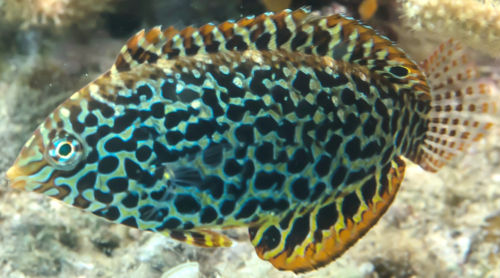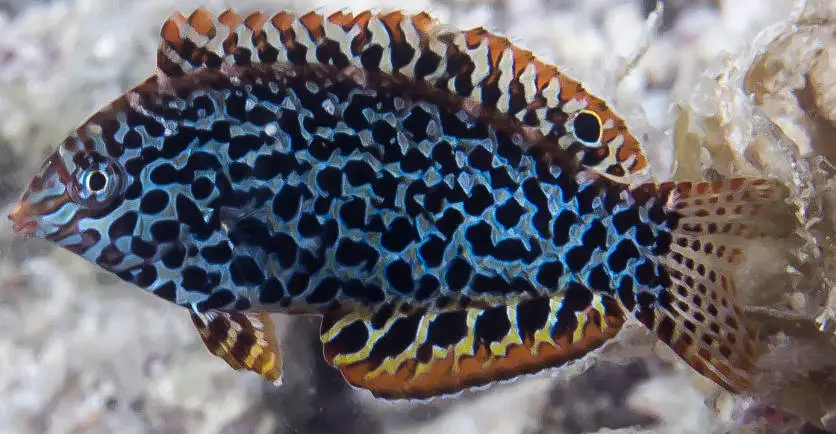
| Scientific Name | Macropharyngodon meleagris) |
| Difficulty | Advanced |
| Minimum Tank Size | 100 Gallons |
| Diet | Carnivore |
| Water Parameters | 72-78 F, pH 8-8.4, Salinity 1.020-1.025 |
| Aggression | Peaceful |
| Size | 6" |
The Leopard wrasse is a mid sized wrasse that is difficult to keep in the home aquarium. They are easily stressed out, reducing their survival rates in new tanks. Unforgiving with changes in the water parameters, only those with extremely stable tanks and a trusted seller should consider the Leopard Wrasse.
The Leopard Wrasse is not a danger to any inverts bigger than a few centimeters. They should not harm any cleaner shrimp, feather dusters or small crabs. Likewise they are not a threat to any corals in the tank.
The great coloration and peaceful nature of the Leopard Wrasse make them fantastic additions to tanks that can handle them. Pair this with their medium size of six inches and you have a big, non bully fish who can keep tanks free of pests that can easily be the star of the tank.
Is the Leopard Wrasse Reef Safe?
The Leopard Wrasse is incredible reef safe. As stated before they will not harm any inverts that are at least half an inch big. They will eat pests, zooplankton and copepods they see on rocks, which is both good and bad depending on what is in your tank.
Corals will never be bothered by the Leopard Wrasse as they do not like bumping into rocks, do not feed on coral and will not pick at their skeletal bases. If you are an experienced aquarist adding tiny frags to the tank and want a reef safe wrasse in the tank, the Leopard Wrasse is a great option.
Usually wrasse who are hungry will prey on larger inverts, but the Leopard Wrasse is still unlikely to ever harm an invert even when starving. If you notice they are being more aggressive than expected try smaller feedings more often, as wrasse eat often and cannot hold meals for long.
Leopard Wrasse hiding
A common trait of the Macropharyngodon family is burrowing, and the Leopard Wrasse is much more prone to doing so than their relatives. They will burrow when frightened or at night to sleep safely and reduce energy consumption. A side effect of this is many aquarists will add the Leopard Wrasse to their tank and not find them for the next two days.
Never dig up the Leopard Wrasse!
Digging up a hiding wrasse will cause an excessive amount of stress. The best thing that can happen when digging these guys up is they run off and burrow somewhere else, which is likely not what you would want anyways. They will come out of the sand when they are hungry and feel more safe in the tank. Scaring them out will not encourage feeding.
Leopard Wrasse Diet
The Leopard Wrasse’s difficulty shows up at feeding time. They have the annoying habit of eating their food, only to spit it out if they do not like the food. This usually happens when changing their diet or if there is a variety of foods in what they are being fed. Thankfully they feed often and can be fed something else they want later if they refuse to eat the planned meal.
A Leopard Wrasse Diet should consist of:
- Finely chopped shrimp
- Frozen mysis or brine shrimp
- Live baby brine shrimp
- Black worms
- Copepods
- Prepared foods, such as pellet and flake
- Seaweed, also known as nori
- Vitamin enriched foods for those fading in color
Keep in mind that wrasse have a different stomach than many other fish. As the Leopard Wrasse swims about so much they have adapted to have a shorter digestive track and smaller stomach. This means they eat more often but less food at a time. The will not do well when only fed once or twice a day. The Leopard Wrasse Should be fed four or five times a day. This may seem crazy but it is one of the trade offs to owning more difficult fish.
Getting them to eat in the tank can be difficult but is made much easier by using live foods. These do cost more than frozen or prepared but could easily be the difference between two weeks of life and five or more years.
Seaweed/nori works best when other fish are eating it. The Leopard Wrasse is unlikely to take bites out of the big piece when hung in a tank but will actively chase down the pieces other fish let fly around the tank.
Getting the Leopard Wrasse to eat prepared food is a coin toss. Some will eat prepared right away, others will spit it out for weeks. To get more stubborn wrasse to eat prepared foods you can try mixing it in with meaty foods. Soaking pellets in the juice from frozen or cut foods will help entice the Leopard Wrasse into taking prepared foods. Given enough time most Leopard Wrasse should grow to accept prepared foods.
One of the easiest ways to keep the Leopard Wrasse well fed is to use two automatic feeders that drop only a small amount of flake food two or three times a day. Combining this with fresher meaty foods like the frozen shrimp will result in a great varied diet that will help keep this delicate wrasse healthy.

Leopard Wrasse Tank Mates
The Leopard Wrasse is very peaceful and should be kept with community fish. Goo tank mates for the Leopard Wrasse include:
- Tangs
- Clownfish
- Butterfly Fish
- Small peaceful wrasse
- Angelfish
As they are peaceful they will not usually fight with other wrasse. Feel free to use them with other wrasse that will not bully the Leopard Wrasse. Most small wrasse, like fairies, four line or flasher wrasse will be fine with the Leopard Wrasse.
The Leopard Wrasse should not be kept in pairs, meaning they do not make good tankmates for themselves. Wrasse will almost always change from female to male when kept in the home aquarium. Keeping two males of the same species with no female to keep them calm is a recipe for fighting. Given how delicate this wrasse is trying to keep two Leopard Wrasse is not worth the risk.
Tank mates that rely on copepods should be avoided at all costs. They Leopard Wrasse is an expert at hunting pods, even if they do not need them/are eating other foods in the tank. Combine this with their larger bodies and you have a fish who will easily keep even a 300 gallon tank low on pods.
Picking out a Leopard Wrasse
This fish does no ship well and should be in transit for a short as possible before reaching your tank. Ordering them online is very risky but the only other option is a high quality local fish store. If you do not have one near you then ordering is likely your best bet.
When choosing a Leopard Wrasse you should look for one who has been eating in captivity and doing well for no less than three weeks. Many stores will get a few of these in stock, only to have them die within a week or two if they are not sold. If your store only has a single Leopard Wrasse in stock you should speak to the store owner and see if you can buy it but keep them in their tank for awhile. If the fish dies shortly after you will usually get a refund and will not have to deal with a dead fish in your own tank.
When you do add them to your tank be sure to slowly acclimate them. Treating the Leopard Wrasse for flukes and worms before adding them to the tank is highly suggested. They are much more prone to flukes than other fish. Prazipro is very effective for this.
Breeding and Gender
The Leopard Wrasse cannot be bred in the home aquarium.
The gender of the Leopard Wrasse is almost synonymous with age. while they are female they will have a white body covered with black spots. As they age and transition into a male they will develop greenish blue dots with orange stripes running along their body.
As previously stated almost all wrasse kept in the home aquarium will transition into males, even if there is another male of the same species in the tank. In the wild a dominant Leopard Wrasse will keep several female wrasse around them, as well as a few sub-males which are females that are waiting to change into males.